Locate the Best Dentist in Eugene Oregon for Your Family's Dental Needs
Locate the Best Dentist in Eugene Oregon for Your Family's Dental Needs
Blog Article
Explore the Array of Dental Issues Dentists Frequently Handle
Dental practitioners are charged with attending to a wide range of oral issues, each calling for specialized knowledge and methods. From the widespread problem of dental caries triggered by microbial task to the more perilous development of gum condition, oral experts need to be adept at very early discovery and treatment. Tooth sensitivity, typically arising from worn enamel, adds another layer of complexity, while the very early recognition of oral cancer can be life-saving. Furthermore, misaligned attacks demand tailored treatment plans to improve both capability and appearances. What details techniques do dental practitioners use to handle these varied difficulties effectively?
Dental Caries and Dental Cavity
Tooth cavities, also recognized as dental caries, are caused by the demineralization of tooth enamel due to acid-producing bacteria in the mouth. If left untreated, dental caries can lead to considerable dental complications, consisting of infections and tooth loss.
To identify cavities and dental cavity, dental professionals employ a mix of visual exams, oral X-rays, and occasionally laser fluorescence devices. Therapy options differ depending on the extent of the decay. Early-stage tooth cavities could be handled with fluoride therapies that assist remineralize the enamel. For even more advanced decay, a dental practitioner may require to remove the endangered tissue and bring back the tooth with dental fillings made from products such as composite resin, amalgam, or porcelain.
Precautionary actions are paramount in combating tooth cavities and dental caries. Normal oral examinations, correct cleaning and flossing strategies, and a balanced diet reduced in sweet foods and drinks are essential methods that sustain dental health and wellness and lessen the risk of cavities.
Periodontal Illness

This causes the periodontals to draw away from the teeth, creating pockets that end up being contaminated. As the body's immune system deals with the bacteria, the bone and connective tissue that hold teeth in location are broken down.
Dental practitioners detect gum tissue condition via clinical examination and gum penetrating to gauge pocket midsts around the teeth. Treatment may include scaling and root planing to remove tartar and microorganisms from tooth surface areas and under the gum tissues.

Tooth Sensitivity
Beyond gum tissue condition, an additional common dental issue that patients frequently come across is tooth level of sensitivity. Characterized by a sharp, short-term discomfort in feedback to stimuli such as warm, cold, wonderful, or acidic foods and beverages, tooth sensitivity can substantially influence a person's top quality of life.
In addition, dental treatments, split teeth, and periodontal disease can reveal the dentin. To reduce tooth sensitivity, dental practitioners might recommend making use of toothpaste created for sensitive teeth, fluoride therapies to enhance enamel, or dental bonding to cover revealed dentin.
Ultimately, addressing tooth level of sensitivity requires a thorough method that consists of both safety nets and targeted therapies to reduce pain and safeguard the oral structures.
Dental Cancer Cells
Oral cancer cells, a severe and potentially lethal problem, frequently flies under the radar in regular oral care conversations. This kind of cancer cells can affect any kind of part of the mouth, including the lips, tongue, cheeks, floor of the mouth, tough and soft tastes buds, sinuses, and throat. Early detection is important for effective therapy, yet several cases are identified at innovative stages because of refined initial signs.
Misaligned Bites
Misaligned attacks, additionally referred to as malocclusions, are an usual oral issue that can dramatically impact both oral health and wellness and total quality of life - eugene dentist. These conditions happen when the top and reduced teeth do not align correctly, bring about difficulties in biting, chewing, and also talking. Malocclusions can be classified into different kinds, consisting of overbites, underbites, crossbites, and open attacks, each offering unique challenges that need tailored treatment techniques
The root causes of misaligned attacks are varied and can consist of hereditary variables, early loss of baby teeth, thumb sucking, and injuries to the jaw. Symptoms typically consist of discomfort or pain in the jaw, regular attacking of the internal cheeks, and a boosted danger of dental caries and gum tissue condition as a result of trouble in keeping dental health.
Dental experts and orthodontists utilize a series of treatments to resolve misaligned attacks, from typical dental braces and clear aligners to advanced surgeries in extreme situations. Early diagnosis and treatment are vital to stop difficulties such as temporomandibular joint (TMJ) problems and irregular endure teeth. With comprehensive evaluation and individualized therapy plans, dental specialists play a pivotal function in correcting malocclusions and boosting clients' oral feature and aesthetics.
Conclusion
Dental experts deal with a range of dental concerns, each with unique challenges and therapy procedures. Tooth cavities and dental cavity result from bacterial activity that compromises tooth enamel, while periodontal illness can escalate from gingivitis to severe periodontal problems. Tooth level of sensitivity entails discomfort from thermal stimuli, hop over to these guys requiring certain treatment. Early discovery of dental cancer cells is essential for reliable treatment. Misaligned attacks impact both dental health and quality of life, commonly requiring orthodontic or medical options to rectify.
To identify dental caries and tooth decay, dental practitioners utilize a mix of visual evaluations, oral X-rays, and occasionally laser fluorescence devices.Beyond periodontal illness, an additional common dental problem that people frequently come across is tooth level of sensitivity. In addition, dental procedures, fractured teeth, and gum tissue disease can expose the dentin. To reduce tooth sensitivity, dental practitioners might recommend utilizing tooth paste developed for delicate teeth, fluoride therapies to enhance enamel, or oral bonding to cover revealed dentin. Dental caries and tooth degeneration result from microbial activity that compromises tooth enamel, while gum why not try this out disease can escalate from gingivitis to severe gum problems.
Report this page